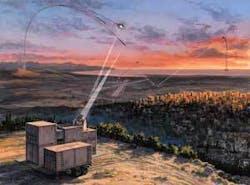By John Keller
REDONDO BEACH, Calif. - Engineers at the Northrop Grumman Corp. Directed Energy Systems segment in Redondo Beach, Calif., are readying mobile high-power laser technology for deployment in the U.S. and abroad against short-range ballistic missiles, short- and long-range rockets, artillery shells, mortars, unmanned aerial vehicles, and cruise missiles.
The Skyguard laser defense system is based on technology that Northrop Grumman experts developed for the Tactical High Energy Laser (THEL) test bed, the Mobile THEL prototype, and its predecessors, which Northrop Grumman developed for the U.S. Army and the Israel Ministry of Defence.
The Tactical High Energy Laser was designed with a high-energy, deuterium fluoride chemical laser to protect against attack by short-range ballistic missiles and similar airborne threats.
Skyguard has higher power and a larger beam than its predecessors. Like earlier prototype systems from Northrop Grumman, Skyguard is a multimission, soldier-operated, compact and transportable laser weapon system designed for field deployment and operations.
This artist’s rendering shows the Skyguard laser weapon as it destroys incoming ballistic missiles, artillery shells, and mortar rounds.
One Skyguard system can defend deployed forces, a large military installation, a large civilian population, or industrial area, Northrop Grumman officials say. One Skyguard system is capable of generating a protective shield of about six miles in diameter.
“We believe that no other weapon of any kind, or any system being developed today, can offer the kind of protection we’ve proven Skyguard can provide,” says Alexis Livanos, president, Northrop Grumman Space Technology. “Skyguard offers the earliest possible implementation of an operational laser weapon system for defense against a wide range of threats.”
In use at the Army’s White Sands Missile Range, N.M., since it was developed between 1996 and 2000, the THEL test bed has shown that laser weapons can protect troops on the ground, company officials say.
During testing, for example, the system shot down 25 Katyusha rockets, which were developed in the former Soviet Union, and are in wide use in the Middle East. In 2004 the Mobile THEL system shot down several mortar rounds in actual mortar-threat scenarios. The THEL prototype intercepted and destroyed single mortar rounds and salvos of mortars.
“The THEL test bed has demonstrated unequivocally that lasers can engage and destroy rocket, artillery, and mortar threats in flight,” says Mike McVey, vice president of Northrop Grumman’s Directed Energy Systems.
“This test bed has been remarkably successful,” McVey says. “To date, it has shot down dozens of live threats, including long- and short-range rockets, mortars and artillery projectiles, in very realistic attack scenarios, and under simulated operational conditions such as surprise attacks and mixed threats.”
The THEL prototype used fire-control radar to establish trajectory information about incoming rockets, and handed off targeting information to the pointer-tracker subsystem (PTS), which included a beam director. The PTS tracks the target optically, then begins a fine tracking process for THEL’s beam director, which places the high-energy laser on target.
The laser’s energy heats the target, which causes its warhead to explode. Like the THEL test bed, Skyguard is a modular and flexible system that will support future spiral developments and can accommodate improved laser and beam-control technologies as they become available.

